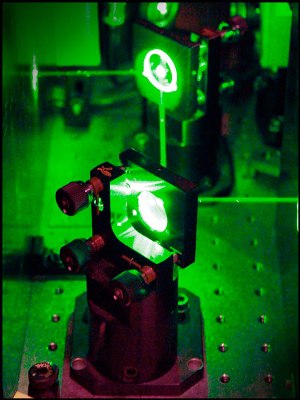Scientists from the Niels Bohr Institute have developed a novel laser cooling method for semiconductor membranes, paving the way to develop efficient cooling systems for components of future ultrasensitive sensors and quantum computers.
 The experiments are carried out in the Quantop laboratories at the Niels Bohr Institute. The laser light that hits the semiconducting nanomembrane is controlled with a forest of mirrors. (Photo: Ola J. Joensen)
The experiments are carried out in the Quantop laboratories at the Niels Bohr Institute. The laser light that hits the semiconducting nanomembrane is controlled with a forest of mirrors. (Photo: Ola J. Joensen)
The quantum optical labs of the Niels Bohr Institute’s Quantop research group have been conducting experiments on laser cooling of atoms for the past several years in order to understand optomechanics, a new field dealing with the interaction between a mechanical motion and an optical radiation or light, according to Eugene Polzik, who is head of the Center of Excellence Quantop at the University of Copenhagen’s Niels Bohr Institute.
In the new cooling method, the researchers used a semiconductor nanomembrane specially designed by them for the optomechanics study. The nanomembrane has 1 mm2 of surface area and 160 nm of thickness. Koji Usami, who serves as an Associate Professor at the Niels Bohr Institute’s Quantop, explained that in the study, the researchers allowed a laser light to interact with the membrane in a vacuum chamber in such a manner that the light that hit the membrane gets affected by the mechanical movements of the membrane. The reflected light from the membrane is reflected back once more using a mirror, which makes the light move back and forth within this space and creates an optical resonator, Usami said.
Usami further said that the light absorbed by the membrane causes the release of free electrons and when the freed electrons get decayed, they heat the membrane, resulting in thermal expansion. In this manner, the distance between the mirror and the membrane continuously fluctuates, he added. The researchers then observed that the membrane’s certain oscillation mode gets cooled down to a temperature of −269°C from room temperature due to the complicated interaction between the optical resonances, the membrane movements and the properties of the semiconductor material, he said. The complex interaction is a result of altering the distance between the mirror and the membrane, which helps controlling the system in order to cool the temperature of the fluctuations of the membrane, he added. This new optomechanical mechanism is the core of the novel finding, he said.